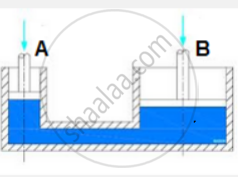Advertisements
Advertisements
प्रश्न
Two cylindrical vessels fitted with pistons A and B of area of cross-section 8 cm2 and 320 cm2 respectively are joined at their bottom by a tube and they are completely filled with water. When a mass of 4 kg is placed on piston A, Find:
- the pressure on piston A,
- the pressure on piston B, and
- the thrust on piston B.
उत्तर

Given that the force applied to the smaller piston A is 4 kg
Area of cross-section of piston A = 8 cm²
Area of cross-section of piston B = 320 cm²
(i) Pressure acting on piston A in the downward direction = `"Thrust"/"Area"`
= `(4 "kg")/(8 "cm"^2)`
∴ Pressure acting on piston A = 0.5 kg cm-2
(ii) According to Pascal's Law
Pressure acting on piston B = Pressure acting on Piston A = 0.5 kg cm-2
(iii) Thrust acting on piston B in the upward direction
= Pressure × Area of B
= 4 kg × `(320 "cm"^2)/(8 "cm"^2)`
∴ Thrust acting on piston B in the upward direction = 160 kgf.
APPEARS IN
संबंधित प्रश्न
How does the density of a body and that of a liquid determine whether the body will float or sink into that liquid?
Which of the following will sink or float on water? (Density of water = 1 g Cm-3)
body D having density 0.85 g m-3
How does the pressure exerted by a solid and fluid differ?
A dam has broader walls at the bottom than at the top. Explain.
Prove that the loss in weight of a body when immersed wholly or partially in a liquid is equal to the buoyant force (or upthrust) and this loss is because of the difference in pressure exerted by liquid on the upper and lower surfaces of the submerged part of body.
The S.I. unit of upthrust is :
Two identical pieces, one of ice (density = 900kg per meter cube) and other wood (density = 300kg per meter cube) float on water.
- Which of the two will have more volume submerged inside water
- Which of two will experience more upthrust due to water.
Select the correct option.
Thrust acting perpendicularly on the unit surface area is called
What is meant by up thrust?
What do you understand by the term “Buoyancy”.
